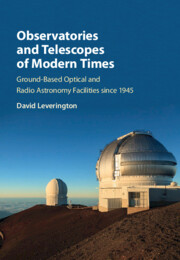 Observatories and Telescopes of Modern Times
Observatories and Telescopes of Modern Times from Part 2 - Radio Observatories
Published online by Cambridge University Press: 15 December 2016
Owens Valley Radio Observatory
Edward G. (Taffy) Bowen, head of the Radiophysics Laboratory in Australia, paid a visit to some old wartime friends during a visit to the United States in 1951. These included Lee DuBridge, the president of Caltech, Robert Bacher, head of the physics department at Caltech, Vannevar Bush, president of the Carnegie Institution in Washington, and Alfred Loomis, a trustee of both the Carnegie Corporation and the Rockefeller Foundation.(1) His discussions with these luminaries of America's scientific establishment tended to focus on the tremendous advances in radio astronomy in Australia and the relatively poor situation of radio astronomy in the United States. So in December 1951 Bacher asked Bowen if he would produce a draft specification for a suitable telescope to get the USA back in the game, whilst shortly afterwards DuBridge asked Bowen to outline the sort of instruments that would be required to build the radio equivalent of the superb optical observatories on Mount Wilson and Palomar Mountain. DuBridge wanted Bowen to be the director of the radio observatory with John Bolton as his deputy. But at this stage Bowen was non-committal about his future as he was also interested in building a large radio telescope in Australia.
In August 1952 Bowen wrote to Vannevar Bush to ask whether Carnegie would consider funding both the proposed Caltech radio telescope and a similar instrument in the southern hemisphere as a collaborative development. This eventually resulted in the trustees of the Carnegie Corporation approving funding in May 1954 for what was to become the Parkes Radio Telescope in Australia (see Section 16.2). In the meantime, as mentioned in the previous chapter, an interdisciplinary conference had been held in Washington, DC in January 1954, jointly sponsored by the NSF, Caltech and the Carnegie Institution, to discuss the state of radio astronomy in the USA and what to do about it. This eventually resulted in the NSF funding the National Radio Astronomy Observatory, whilst Caltech decided to go it alone and build their own observatory which was largely funded in the early years by the US Office of Naval Research.
To save this book to your Kindle, first ensure [email protected] is added to your Approved Personal Document E-mail List under your Personal Document Settings on the Manage Your Content and Devices page of your Amazon account. Then enter the ‘name’ part of your Kindle email address below. Find out more about saving to your Kindle.
Note you can select to save to either the @free.kindle.com or @kindle.com variations. ‘@free.kindle.com’ emails are free but can only be saved to your device when it is connected to wi-fi. ‘@kindle.com’ emails can be delivered even when you are not connected to wi-fi, but note that service fees apply.
Find out more about the Kindle Personal Document Service.
To save content items to your account, please confirm that you agree to abide by our usage policies. If this is the first time you use this feature, you will be asked to authorise Cambridge Core to connect with your account. Find out more about saving content to Dropbox.
To save content items to your account, please confirm that you agree to abide by our usage policies. If this is the first time you use this feature, you will be asked to authorise Cambridge Core to connect with your account. Find out more about saving content to Google Drive.